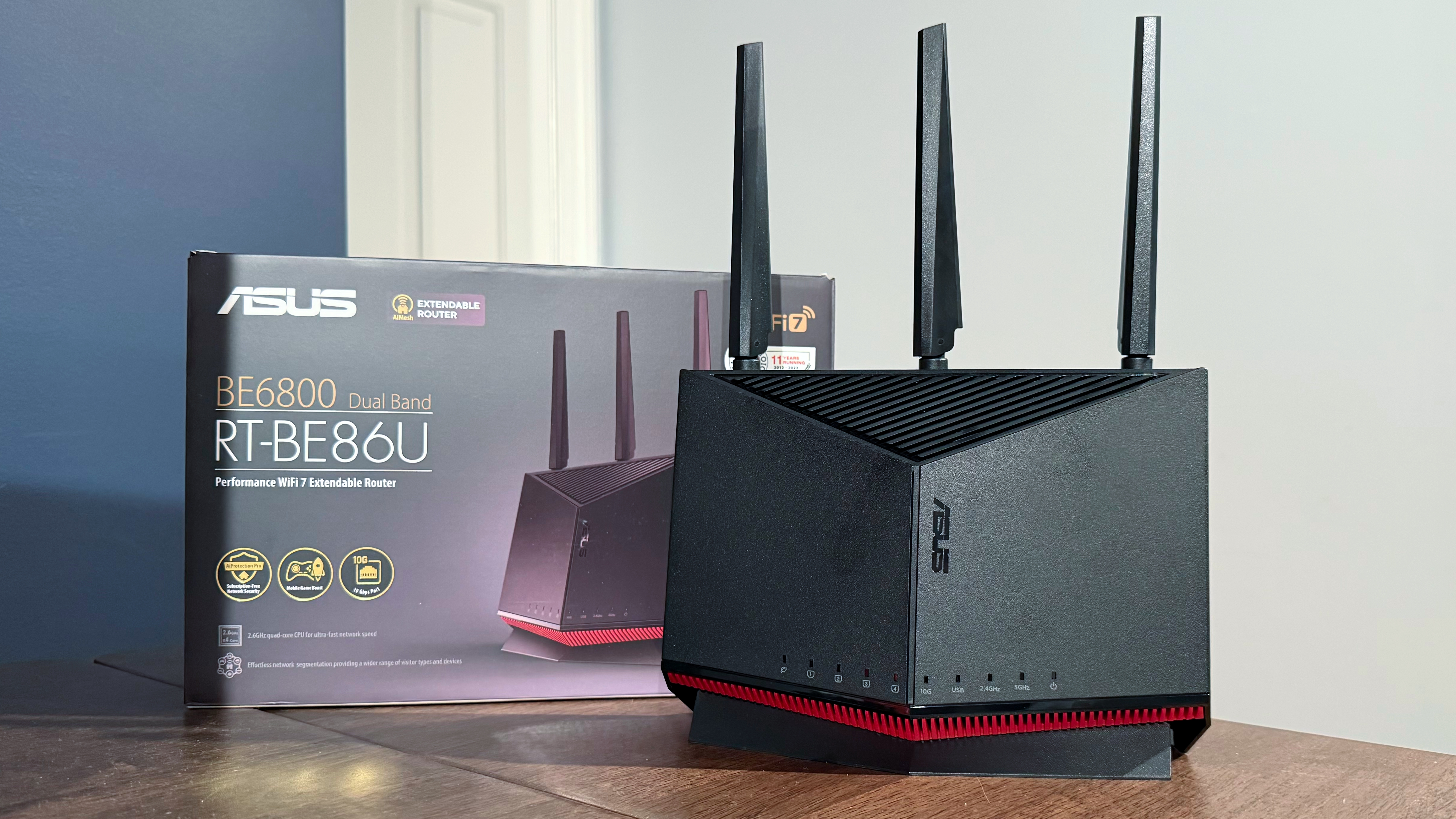9,000 Asus routers compromised by botnet attack and persistent SSH backdoor that even firmware updates can't fix
The backdoor evades detection and survives firmware updates

Thousands of Asus routers have been compromised due to a newly discovered botnet called ‘AyySSHush.’ The stealth attack was detected in March 2025 by cybersecurity firm GreyNoise, which reportedly exploits authentication and makes use of the router features to maintain long-term access. Notably, the backdoor does not make use of any malware, and the unauthorized access cannot be removed using firmware updates.
The attack begins with threat actors targeting the routers through brute-force login attempts and exploiting authentication bypass techniques, some of which remain undocumented without assigned CVEs. Once inside, they target and exploit CVE-2023-39780, a known command injection vulnerability, to execute arbitrary system-level commands. This technique allows the attackers to manipulate the router’s configuration using legitimate functions within the firmware.
The attackers use official Asus router features to gain persistent access. They also gain the ability to enable SSH on a non-standard port (TCP 53282) and install their own public SSH key, enabling remote administrative control. Since the backdoor is written to the router’s non-volatile memory (NVRAM), it can survive both firmware updates and device reboots. Additionally, by disabling system logging and the router’s AiProtection security features, the attackers ensure that they cannot be detected.
According to GreyNoise’s report, the techniques used by the attackers suggest thorough planning for long-term access and demonstrate a deep knowledge of the system’s architecture. Over 9,000 Asus routers have been confirmed as compromised, according to data from Censys, a platform that monitors and maps internet-facing devices globally. Censys identifies devices that are exposed to the internet, while GreyNoise detects which of those devices are being actively targeted or exploited. This offers a clearer picture of both the scale and stealth of the ongoing campaign.
The discovery of the exploit was made using GreyNoise’s AI-powered analysis tool called 'Sift.' It flagged just three HTTP POST requests targeting Asus router endpoints for deeper inspection, which were then observed using emulated Asus profiles running factory firmware. Surprisingly, Sift detected only 30 malicious requests over a period of three months, despite compromising thousands of devices.
Asus has released a new firmware update addressing CVE-2023-39780, as well as the initial undocumented login bypass techniques. However, the update is more or less a preventive measure. Any router that has been exploited previously, upgrading the firmware is not going to remove the SSH backdoor. This is because the malicious configuration changes are stored in non-volatile memory and are not overwritten during standard firmware upgrades.
To ensure routers are fully secured, users are advised to take additional manual steps, including checking for active SSH access on TCP port 53282, reviewing the authorized_keys file for unfamiliar entries, and blocking the known malicious IP addresses that may be associated with the campaign. If a device is suspected to be compromised, it is best to perform a full factory reset and then reconfigure the router from the beginning.
Get Tom's Hardware's best news and in-depth reviews, straight to your inbox.
Follow Tom's Hardware on Google News to get our up-to-date news, analysis, and reviews in your feeds. Make sure to click the Follow button.

Kunal Khullar is a contributing writer at Tom’s Hardware. He is a long time technology journalist and reviewer specializing in PC components and peripherals, and welcomes any and every question around building a PC.
-
newtechldtech easier solution : use very long complicated password ... brute force will take forever and will fail.Reply -
Redempshin Come on....Reply
The backdoor evades detection
That's just painfully wrong. They attackers turned on SSH on a specific port, created an additional login and turned off security functions. Those are all VERY detectable.
The ACTUAL information from GreyNoise says
router logging is disabled to evade detection.
You could say "the attackers took steps to try and avoid detection".
And then this:
and survives firmware updates
It might be more honest to say "The most recent ASUS firmware does not remove the attackers access to systems"
An ASUS firmware patch (in addition to fixing the original 'undocumented authentication bypass technique') can simply re-disable SSH, nuke any SSH keys, and then turn off/on anything that was part of the deployment package in this attack. Patch notes "if you had previously enabled ssh, added your own SSH keys, enabled remote access, disabled the security features on your router, you'll need to do that again." -
das_stig Reply
This is TH that excels in inaccurate scare mongering, that helps makes clicks for TH advertising machine.Redempshin said:Come on....
That's just painfully wrong. They attackers turned on SSH on a specific port, created an additional login and turned off security functions. Those are all VERY detectable.
The ACTUAL information from GreyNoise says
You could say "the attackers took steps to try and avoid detection".
And then this:
It might be more honest to say "The most recent ASUS firmware does not remove the attackers access to systems"
An ASUS firmware patch (in addition to fixing the original 'undocumented authentication bypass technique') can simply re-disable SSH, nuke any SSH keys, and then turn off/on anything that was part of the deployment package in this attack. Patch notes "if you had previously enabled ssh, added your own SSH keys, enabled remote access, disabled the security features on your router, you'll need to do that again."
TH stops being a reliable news source years ago and now just a minor content platform for advertising !! -
Makaveli Reply
Thank you.Redempshin said:Come on....
That's just painfully wrong. They attackers turned on SSH on a specific port, created an additional login and turned off security functions. Those are all VERY detectable.
The ACTUAL information from GreyNoise says
You could say "the attackers took steps to try and avoid detection".
And then this:
It might be more honest to say "The most recent ASUS firmware does not remove the attackers access to systems"
An ASUS firmware patch (in addition to fixing the original 'undocumented authentication bypass technique') can simply re-disable SSH, nuke any SSH keys, and then turn off/on anything that was part of the deployment package in this attack. Patch notes "if you had previously enabled ssh, added your own SSH keys, enabled remote access, disabled the security features on your router, you'll need to do that again."
I'm running an Asus AX88U Pro but with merlin firmware.
I do have SSH enabled but only for local lan and not for external access which is a security risk. Decided to check active sessions anyways for any activity on TCP 53282 and nothing. So i'm good. -
Redempshin Reply
So....the blog post discusses that its actually very quiet because the bad guy is building an army and waiting. Traffic/open sessions isn't the issue. Scan the interface and see if that port is open.Makaveli said:I do have SSH enabled but only for local lan and not for external access which is a security risk. Decided to check active sessions anyways for any activity on TCP 53282 and nothing. So i'm good. -
Redempshin Reply
Yeah, I got that vibe, I haven't been here in years and hadn't realized it had gotten so bad.das_stig said:This is TH that excels in inaccurate scare mongering, that helps makes clicks for TH advertising machine.
TH stops being a reliable news source years ago and now just a minor content platform for advertising !! -
Makaveli Reply
should have added I did a port scan also this port is closed.Redempshin said:So....the blog post discusses that its actually very quiet because the bad guy is building an army and waiting. Traffic/open sessions isn't the issue. Scan the interface and see if that port is open. -
wakuwaku Reply
The main issue with all of this is that despite all these repeated multiple failures, other sites/people that seemingly try to keep their standards up do not realize TH is garbage and keep citing/quoting TH without fact checking TH, making them seem as the "authoritative" source of tech news, even repeating the same errors TH makes.Redempshin said:Yeah, I got that vibe, I haven't been here in years and hadn't realized it had gotten so bad.
This in return, probably makes TH staff think they are not doing anything bad/wrong, instead they think the ones in the wrong are their readers. Its a vicious cycle. -
bill001g Reply
I am not so sure how TH staff is really left. Most article that are actually written by TH employees I don't have many issues with. Some of the testing articles are very impressive.wakuwaku said:
This in return, probably makes TH staff think they are not doing anything bad/wrong, instead they think the ones in the wrong are their readers. Its a vicious cycle.
A massive amount of TH content is written by independent self proclaimed "journalists". AI could do better than some of them, when all they do is summarize articles published someplace else. Then again a huge number of people only read the headline and even if they read the article they will not check to see if the original source of the information really matches the article.